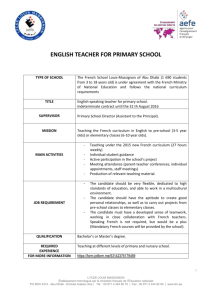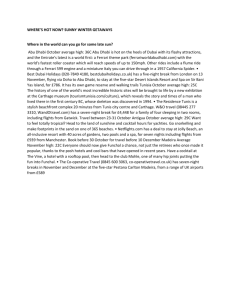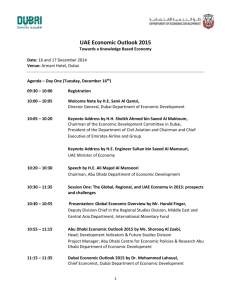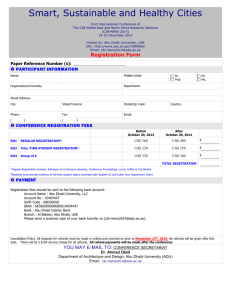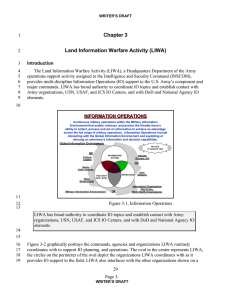Rags to riches - learningenglishwithrobyn
advertisement
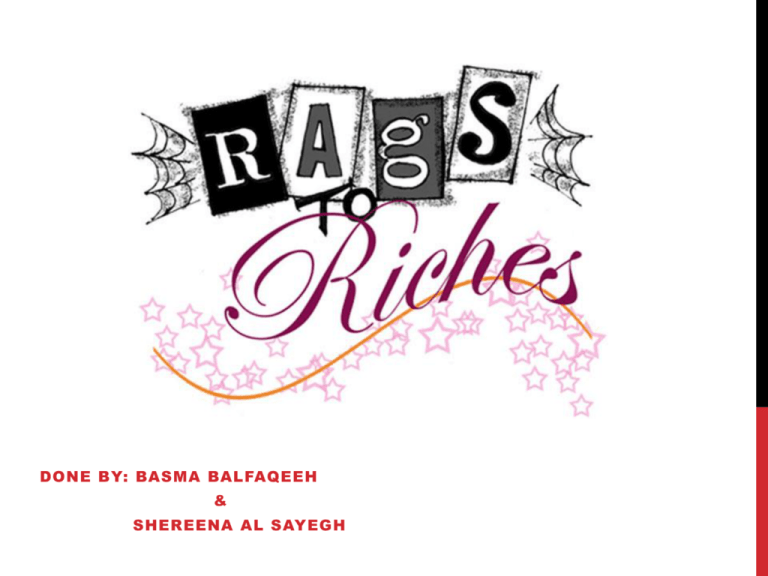
DONE BY: BASMA BALFAQEEH & SHEREENA AL SAYEGH INTRODUCTION Rags to riches is a story written by Mohammed Al Fahim. It’s a story about how people lived their lives a long time ago. Topics we will talk about : • The simple lives of the Bedouins • The food they ate • The shopping they did SIMPLE LIVES' OF THE BEDOUINS How it began: In 1946 Abu Dhabi’s population nearly reached to 6 thousand people Mid 1950’s population dropped because of the collapse of pearl industry Also many citizens emigrated to Al Ain, Liwa and other parts of the gulf How they lived: Tribes kept to their own camps which were separated from other tribes Harsh weather made people hesitant to live in Abu Dhabi Women and children moved either to Al Ain or Liwa. While men were pearl diving. Barely anyone stayed in Abu Dhabi because of lack of fresh water, high humidity and poor living conditions. People wore the same clothes in winter as in summer. Winter time the whole family huddled in one corner to stay warm throughout the night. In summer they used to sleep outside for cold breeze. How they transported: Long distance trips were made on the back of a camel Dubai, Sharjah and Ras Al Khaimah were reached by a boat It took approximately 7 days to travel between Abu Dhabi and Al Ain or Liwa. Took 3-4 days to reach Dubai Usually people travelled in a caravan of 20 - 30 camels for security and companionship Until late 1950’s no one owned a car, except a few ruling family members Their houses: Made out of palm fronds, wealthier families lived in clay houses and Sheikh lived in a palace Houses were grouped together for security, companionship and warmth during the cooler months People built houses away from the sea to protect them from the cold wind and high humidity in summer Mats were used as flooring in the tents and huts Woven mats were used for sitting, sleeping and insulating the tents. Also they were formed into roofs for the huts. SHOPPING The souk had 2 rows of shops facing each other, about 30 shops in total The size of each shop was about nine square meters Some shops were made of mud and some out of palm fronds Most sold the same goods; usually sold rice, flour, sugar and coffee also textiles They used to tailor at home since they didn’t have ready made clothes There were no merchandise that interests children, such as: toys, sweets and biscuits 1963 some shopkeepers brought sweets, biscuits, dried powder orange juice and marbles for playing Various shops started selling lemonade in bottles FOOD Cooking was done over a wood fire, which was a chore to women Finding fuel for the fire wasn’t easy to find being in the desert Gathered any drift wood they found from the sea shore They added the wood to flammable material gathered from the few date palms in the area Also brought wood from the Bedouins Mostly ate rice, fish, yogurt and dates Rice was imported from India through Dubai Dates were imported from Bahrain They didn’t eat meat since they needed the animals for the milk They never ate fish for dinner because it will rot Al Ain and Liwa never ate fresh fish, they ate it dry Men and women ate separately Liquid refreshments consisted of tea and Arabic coffee If needed they borrowed food from neighbors if a visitor came Word Definition Sentence Bandits Robbers Sara heard there is a lot of bandits in Italy. Eke Make friends eke the world go round Fodder Food humans can’t live without fodder Foe Enemy never be mean to your enemies Dwellers Residents Deplorable To be violent the zoo keeper was deplorable with the elephants Arduous Hard jenny studied arduously for her math exam Combustible Flammable those palm tree leaf houses are easily flammable Prefabricated Produced the candy was produced in 2011 Leisure Rest Fatima wanted to leisure in the Maldives for her holiday -
